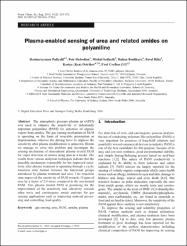Plasma-enabled sensing of urea and related amides on polyaniline

Göster/Aç
Erişim
info:eu-repo/semantics/embargoedAccessTarih
2016Yazar
Puliyalil, HarinarayananSlobodian, Petr
Sedlacik, Michal
Benlikaya, Ruhan
Riha, Pavel
Ostrikov, Kostya (Ken)
Cvelbar, Uros
Üst veri
Tüm öğe kaydını gösterÖzet
The atmospheric pressure plasma jet (APPJ) was used to enhance the sensitivity of industrially important polyaniline (PANI) for detection of organic vapors from amides. The gas sensing mechanism of PANI is operating on the basis of reversible protonation or deprotonation, whereas the driving force to improve the sensitivity after plasma modifications is unknown. Herein we manage to solve this problem and investigate the sensing mechanism of atmospheric plasma treated PANI for vapor detection of amides using urea as a model. The results from various analytical techniques indicate that the plausible mechanism responsible for the improved sensitivity after plasma treatment is operating through a cyclic transition state formed between the functional groups introduced by plasma treatment and urea. This transition state improved the sensitivity of PANI towards 15 ppm of urea by a factor of 2.4 times compared to the non-treated PANI. This plasma treated PANI is promising for the improvement of the sensitivity and selectivity towards other toxic and carcinogenic amide analytes for gas sensing applications such as improving material processing and controlling food quality.

















